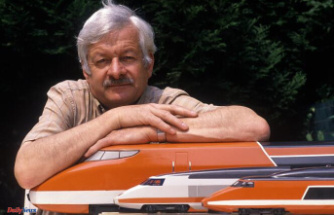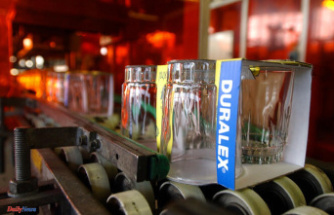Very soon, in the next few months, the first cars will be driving independently on the roads in Germany. How do test centers like TÜV Süd prepare to test such systems for reliability? This can be observed at a test and proving ground in Hungary.
Relaxed, the Mercedes follows a Kia at motorway speed. At a sufficient distance. The passengers talk, listen to music, are distracted. Suddenly a Ford Fiesta pushes into the previously large gap - and brakes. The Mercedes starts beeping and shortly thereafter automatically applies the brakes - without the driver touching the brake pedal.
The passengers jerk forward, belts hold their bodies. The Mercedes comes to a standstill just a few centimeters in front of the Fiesta. This is an uncomfortable situation that can happen on a daily basis. Here it was just an attempt on a proving ground. test passed.
The Fiesta as a target vehicle is a GST, a "Guided Soft Target". It's just a white shell in the shape of the small car on a four-wheel remote-controlled platform. On the 265 hectare area of the AVL Zalazone test and proving ground in Hungary, driver assistance and autonomous systems can be checked on a motorway section, a high-speed oval and a handling course.
A 15-hectare smart city zone will be added for future tests - for scenarios in the city. "Such tests cannot be checked safely and reproducibly on public roads, so we need a closed-off route," says Robert Matawa, Head of Testing for Highly Automated Driving at TÜV Süd. The site is around 50 kilometers from Lake Balaton and is operated by an Austro-Hungarian joint venture.
"These experiments are harmless and we can carry them out again and again, with exactly the same speeds," says Alexander Kraus. The head of the technology department at TÜV Süd develops test methods for Level 3 and Level 4 systems with a team. These include assistance systems with which cars can drive automatically, i.e. independently.
However, previous Level 2 systems, such as the emergency brake assistant, are also checked. In conjunction with active cruise control, this can independently accelerate and brake the car. In order for the manufacturers to obtain approval for this and to be able to sell the systems, a testing company must check and approve them.
Inspectors are sitting in the Mercedes and are checking the active assistance systems. Peppered with additional monitors, switches and cables in the footwell, the car becomes a test laboratory on wheels. To ensure that the cars always drive at the same speed, the engineer activates a driving pilot before driving. Similar to a robot, the system takes control over the short stretch and accelerates to motorway speed.
Thanks to digital maps accurate to two centimeters, the Kia drives along the route as a Traffic Simulation Vehicle (TSV), closely followed by the Mercedes. Only when the Kia pulls away does the Fiesta cut in from the right and brake the Mercedes. The occupants have to trust the car to brake in time. An unfamiliar and uncomfortable feeling.
After emergency braking, the computer saves the data in the Mercedes. Engineer Robert Matawa pulls off the track, restarts the system and begins another attempt. "We have to make sure that the systems are working correctly and reliably, so we check them several times," he says. Because an emergency brake assistant must never fail. For the independent tests, the testing company rents the vehicles from a car rental company.
The testing effort will increase significantly for future systems for autonomous driving. The inspectors must also ensure that the vehicle always works properly according to the prescribed guidelines. Except that the systems are becoming increasingly complex. To this end, TÜV Süd accompanies the development of the manufacturers who commission it, checks the software at an early stage, simulates it and uses it to develop its own tests and scenarios in all conceivable traffic and everyday situations for practical use.
Only when the simulated tests are successful does it go to the test track like in Hungary. "We don't advise car manufacturers, but as an independent service provider we check their systems for function and reliability. We carry out purely technical checks," Alexander Kraus clarifies.
In the future, cars will simulate everyday traffic in smart cities, whatever the weather. Because it doesn't matter whether it's raining, fogging or snowing: the safety systems either have to work reliably or hand the steering work back to the driver. Otherwise the cars simply stand still in the rain or snow.
So far, such tests could only be simulated, but not tested in practice. Nevertheless, a simulation is important. "Results from the simulation can be developed faster," says Alexander Kraus. They could then be transferred and controlled directly in cars via software updates. "In this way, the test drive can be started more quickly and the systems released," he says.
In the past, automakers developed new technologies faster than testing organizations could test and approve them for safety. Legal regulations therefore often lag behind the technical possibilities - worldwide.
A few months ago, Mercedes-Benz showed that this can work quite quickly. Some vehicles are allowed to drive semi-autonomously according to Level 3. The Federal Motor Transport Authority (KBA) has granted the manufacturer the system approval for Germany. With the so-called traffic jam assistant, such cars then follow a vehicle in front at a speed of up to 60 km/h and steer and brake independently.
Soon even more will be possible: According to a decision made a few weeks ago by the UNECE, the World Forum for the Harmonization of Vehicle Regulations of the UN Economic Commission, the maximum speed for autonomous driving in certain traffic situations will be increased from 60 to 130 km/h. Lane changes should also be allowed. According to the UNECE at the end of June, the EU has already announced implementation. National regulations must be adapted for this.
However, the area of application remains limited for the time being: the new rules only apply to roads that are not allowed to be used by pedestrians and cyclists - such as motorways.












